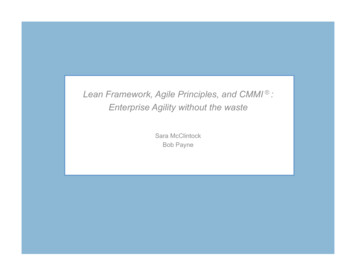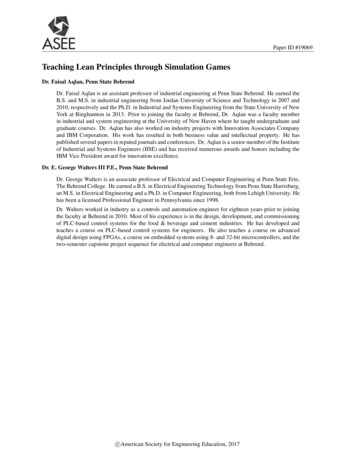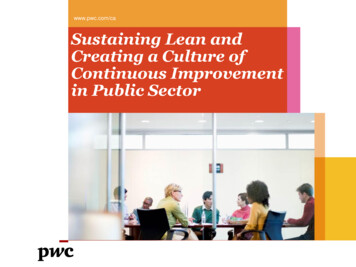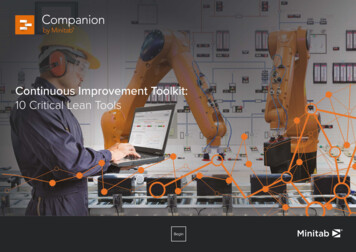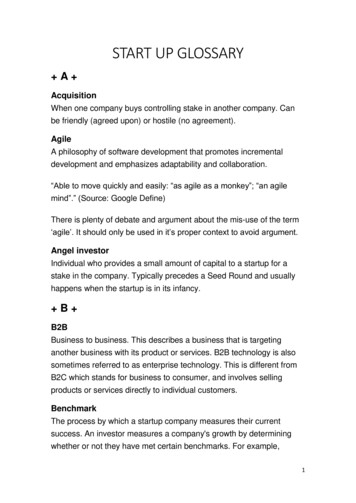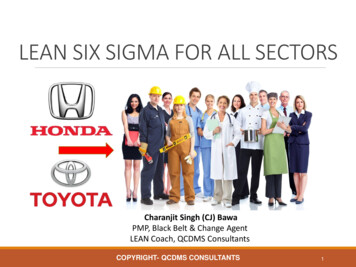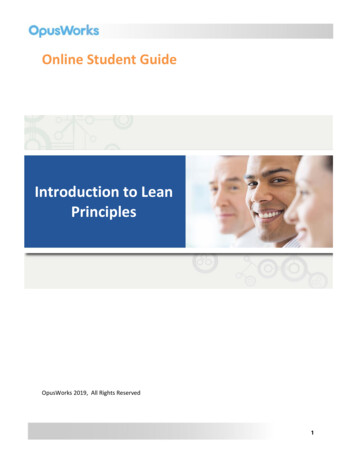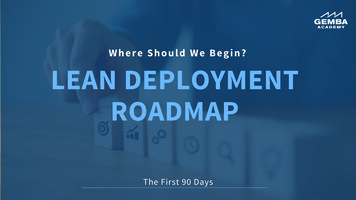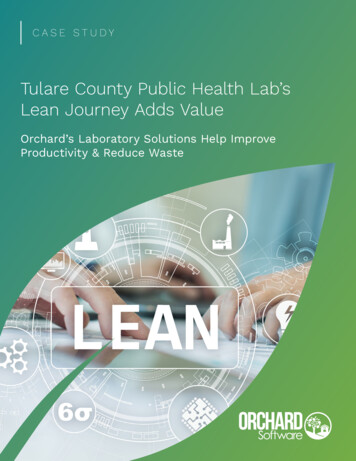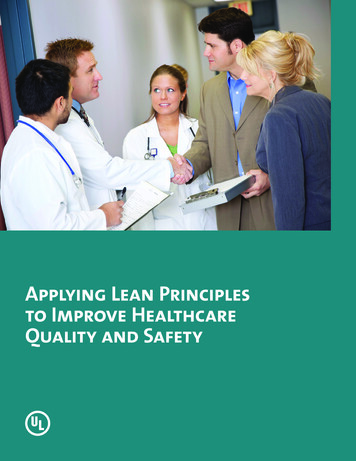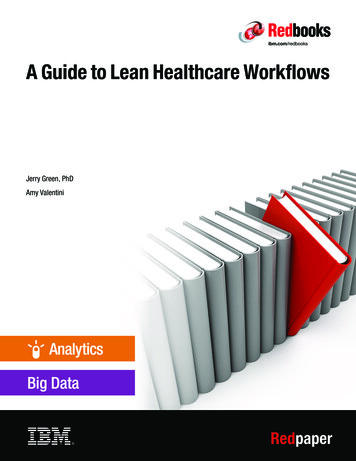
Transcription
Front coverA Guide to Lean Healthcare WorkflowsJerry Green, PhDAmy ValentiniRedpaper
International Technical Support OrganizationA Guide to Lean Healthcare WorkflowsAugust 2015REDP-5240-00
Note: Before using this information and the product it supports, read the information in “Notices” onpage vii.First Edition (August 2015)This edition is about the Lean methodology. Copyright International Business Machines Corporation 2015. All rights reserved.Note to U.S. Government Users Restricted Rights -- Use, duplication or disclosure restricted by GSA ADP ScheduleContract with IBM Corp.
ContentsNotices . . . . . . . . . . . . . . . . . . . . . . . . . . . . . . . . . . . . . . . . . . . . . . . . . . . . . . . . . . . . . . . . . viiTrademarks . . . . . . . . . . . . . . . . . . . . . . . . . . . . . . . . . . . . . . . . . . . . . . . . . . . . . . . . . . . . . viiiIBM Redbooks promotions . . . . . . . . . . . . . . . . . . . . . . . . . . . . . . . . . . . . . . . . . . . . . . . . . ixPreface . . . . . . . . . . . . . . . . . . . . . . . . . . . . . . . . . . . . . . . . . . . . . . . . . . . . . . . . . . . . . . . . . xiAuthors . . . . . . . . . . . . . . . . . . . . . . . . . . . . . . . . . . . . . . . . . . . . . . . . . . . . . . . . . . . . . . . . . . xiNow you can become a published author, too! . . . . . . . . . . . . . . . . . . . . . . . . . . . . . . . . . . xiiiComments welcome. . . . . . . . . . . . . . . . . . . . . . . . . . . . . . . . . . . . . . . . . . . . . . . . . . . . . . . xiiiStay connected to IBM Redbooks . . . . . . . . . . . . . . . . . . . . . . . . . . . . . . . . . . . . . . . . . . . . xivChapter 1. Introduction. . . . . . . . . . . . . . . . . . . . . . . . . . . . . . . . . . . . . . . . . . . . . . . . . . . .1.1 Stopping the confusion and Lean first . . . . . . . . . . . . . . . . . . . . . . . . . . . . . . . . . . . . . . .1.2 Failure does not have to be an option . . . . . . . . . . . . . . . . . . . . . . . . . . . . . . . . . . . . . . .1.3 Purpose of this publication . . . . . . . . . . . . . . . . . . . . . . . . . . . . . . . . . . . . . . . . . . . . . . .1.4 What Is Lean . . . . . . . . . . . . . . . . . . . . . . . . . . . . . . . . . . . . . . . . . . . . . . . . . . . . . . . . . .1.4.1 Five Lean steps in sequence . . . . . . . . . . . . . . . . . . . . . . . . . . . . . . . . . . . . . . . . .123444Chapter 2. Defining value from the patient's perspective . . . . . . . . . . . . . . . . . . . . . . . . 52.1 Identifying the area to investigate . . . . . . . . . . . . . . . . . . . . . . . . . . . . . . . . . . . . . . . . . . 62.2 Creating a sense of urgency . . . . . . . . . . . . . . . . . . . . . . . . . . . . . . . . . . . . . . . . . . . . . . 62.3 Starting the charter . . . . . . . . . . . . . . . . . . . . . . . . . . . . . . . . . . . . . . . . . . . . . . . . . . . . . 62.4 Getting a champion . . . . . . . . . . . . . . . . . . . . . . . . . . . . . . . . . . . . . . . . . . . . . . . . . . . . . 72.5 Agreeing on the scope with the champion . . . . . . . . . . . . . . . . . . . . . . . . . . . . . . . . . . . 72.6 Assembling the core project team . . . . . . . . . . . . . . . . . . . . . . . . . . . . . . . . . . . . . . . . . . 72.7 Developing a simple SIPOC map . . . . . . . . . . . . . . . . . . . . . . . . . . . . . . . . . . . . . . . . . . 82.7.1 Starting with the inputs by using the 5Ms and P method . . . . . . . . . . . . . . . . . . . . 82.8 Defining patient basic needs by using the Kano model . . . . . . . . . . . . . . . . . . . . . . . . 102.9 Categorizing and labeling patient needs . . . . . . . . . . . . . . . . . . . . . . . . . . . . . . . . . . . . 132.10 Tollgate 1: Reviewing the value as defined by the patient . . . . . . . . . . . . . . . . . . . . . 14Chapter 3. Mapping the value stream and identifying issues and constraints . . . . . .3.1 What is a value stream . . . . . . . . . . . . . . . . . . . . . . . . . . . . . . . . . . . . . . . . . . . . . . . . .3.2 How many value streams does your organization have . . . . . . . . . . . . . . . . . . . . . . . .3.3 Benefits of value stream mapping . . . . . . . . . . . . . . . . . . . . . . . . . . . . . . . . . . . . . . . . .3.4 Mapping the value stream . . . . . . . . . . . . . . . . . . . . . . . . . . . . . . . . . . . . . . . . . . . . . . .3.4.1 Traditional value stream map . . . . . . . . . . . . . . . . . . . . . . . . . . . . . . . . . . . . . . . .3.4.2 Identifying the entity . . . . . . . . . . . . . . . . . . . . . . . . . . . . . . . . . . . . . . . . . . . . . . .3.4.3 Thinking horizontally . . . . . . . . . . . . . . . . . . . . . . . . . . . . . . . . . . . . . . . . . . . . . . .3.4.4 Identifying the entity start point . . . . . . . . . . . . . . . . . . . . . . . . . . . . . . . . . . . . . . .3.4.5 Identifying the entity stop point . . . . . . . . . . . . . . . . . . . . . . . . . . . . . . . . . . . . . . .3.4.6 Naming it end-to-end . . . . . . . . . . . . . . . . . . . . . . . . . . . . . . . . . . . . . . . . . . . . . .3.4.7 Identifying process steps . . . . . . . . . . . . . . . . . . . . . . . . . . . . . . . . . . . . . . . . . . .3.4.8 Preparing for mapping . . . . . . . . . . . . . . . . . . . . . . . . . . . . . . . . . . . . . . . . . . . . .3.4.9 Mapping . . . . . . . . . . . . . . . . . . . . . . . . . . . . . . . . . . . . . . . . . . . . . . . . . . . . . . . .3.5 Calculating the time that is spent on each activity and line on the map . . . . . . . . . . . .3.5.1 Estimating the time for the hidden factory and adding it to the total time . . . . . . .3.6 Conducting a value-add flow analysis . . . . . . . . . . . . . . . . . . . . . . . . . . . . . . . . . . . . . .3.6.1 Value-add criteria . . . . . . . . . . . . . . . . . . . . . . . . . . . . . . . . . . . . . . . . . . . . . . . . . Copyright IBM Corp. 2015. All rights reserved.151616161617171818181919192023242525iii
iv3.6.2 Applying red dots and green dots to the map . . . . . . . . . . . . . . . . . . . . . . . . . . . .3.6.3 Evaluating the type of waste for each red dot . . . . . . . . . . . . . . . . . . . . . . . . . . . .3.7 Going to Gemba . . . . . . . . . . . . . . . . . . . . . . . . . . . . . . . . . . . . . . . . . . . . . . . . . . . . . .3.8 Identifying the value stream's constraints . . . . . . . . . . . . . . . . . . . . . . . . . . . . . . . . . . .3.9 Tollgate 2: Reviewing the map with key stakeholders . . . . . . . . . . . . . . . . . . . . . . . . .3.10 Prioritizing the issues by using a Failure Mode and Effects Analysis . . . . . . . . . . . . .3.11 Tollgate 3: Reviewing the FMEA and Priority Matrix with key stakeholders . . . . . . . .25262829303140Chapter 4. Removing waste and making the value flow without interruption. . . . . . .4.1 Goal of this step . . . . . . . . . . . . . . . . . . . . . . . . . . . . . . . . . . . . . . . . . . . . . . . . . . . . . .4.2 Eliminating. . . . . . . . . . . . . . . . . . . . . . . . . . . . . . . . . . . . . . . . . . . . . . . . . . . . . . . . . . .4.2.1 Handoffs . . . . . . . . . . . . . . . . . . . . . . . . . . . . . . . . . . . . . . . . . . . . . . . . . . . . . . . .4.2.2 Redundancy . . . . . . . . . . . . . . . . . . . . . . . . . . . . . . . . . . . . . . . . . . . . . . . . . . . . .4.2.3 Approvals . . . . . . . . . . . . . . . . . . . . . . . . . . . . . . . . . . . . . . . . . . . . . . . . . . . . . . .4.2.4 Unnecessary walking . . . . . . . . . . . . . . . . . . . . . . . . . . . . . . . . . . . . . . . . . . . . . .4.3 Automating . . . . . . . . . . . . . . . . . . . . . . . . . . . . . . . . . . . . . . . . . . . . . . . . . . . . . . . . . .4.3.1 New technology . . . . . . . . . . . . . . . . . . . . . . . . . . . . . . . . . . . . . . . . . . . . . . . . . .4.3.2 Poka Yoke. . . . . . . . . . . . . . . . . . . . . . . . . . . . . . . . . . . . . . . . . . . . . . . . . . . . . . .4.4 Simplifying . . . . . . . . . . . . . . . . . . . . . . . . . . . . . . . . . . . . . . . . . . . . . . . . . . . . . . . . . . .4.4.1 5S . . . . . . . . . . . . . . . . . . . . . . . . . . . . . . . . . . . . . . . . . . . . . . . . . . . . . . . . . . . . .4.4.2 Colocating and sequencing tasks . . . . . . . . . . . . . . . . . . . . . . . . . . . . . . . . . . . . .4.4.3 Standardizing . . . . . . . . . . . . . . . . . . . . . . . . . . . . . . . . . . . . . . . . . . . . . . . . . . . .4.4.4 Reducing motion . . . . . . . . . . . . . . . . . . . . . . . . . . . . . . . . . . . . . . . . . . . . . . . . . .4.4.5 Reducing multitasking . . . . . . . . . . . . . . . . . . . . . . . . . . . . . . . . . . . . . . . . . . . . . .4.4.6 Balancing resources . . . . . . . . . . . . . . . . . . . . . . . . . . . . . . . . . . . . . . . . . . . . . . .4.4.7 Reducing defects . . . . . . . . . . . . . . . . . . . . . . . . . . . . . . . . . . . . . . . . . . . . . . . . .4.5 Building a buffer . . . . . . . . . . . . . . . . . . . . . . . . . . . . . . . . . . . . . . . . . . . . . . . . . . . . . .4.5.1 Calculating how much time for the patient to wait. . . . . . . . . . . . . . . . . . . . . . . . .4.6 Mapping the value stream with the solutions in mind . . . . . . . . . . . . . . . . . . . . . . . . . .4.7 Conclusion . . . . . . . . . . . . . . . . . . . . . . . . . . . . . . . . . . . . . . . . . . . . . . . . . . . . . . . . . .4.8 Tollgate 4: Reviewing solution ideas with key stakeholders . . . . . . . . . . . . . . . . . . . . pter 5. Implementing the solution and allowing patients to pull value . . . . . . . . .5.1 Following the kaizen philosophy . . . . . . . . . . . . . . . . . . . . . . . . . . . . . . . . . . . . . . . . . .5.1.1 Do not forget the other two components . . . . . . . . . . . . . . . . . . . . . . . . . . . . . . . .5.1.2 Piloting when possible . . . . . . . . . . . . . . . . . . . . . . . . . . . . . . . . . . . . . . . . . . . . .5.1.3 Allowing patients to pull value . . . . . . . . . . . . . . . . . . . . . . . . . . . . . . . . . . . . . . . .5.1.4 Design in a visual management system . . . . . . . . . . . . . . . . . . . . . . . . . . . . . . . .5.1.5 Using Kanban cards for supplies . . . . . . . . . . . . . . . . . . . . . . . . . . . . . . . . . . . . .5.1.6 Using a Kanban signal for the patient . . . . . . . . . . . . . . . . . . . . . . . . . . . . . . . . . .5.2 Following a robust change management process. . . . . . . . . . . . . . . . . . . . . . . . . . . . .5.2.1 Kotter's eight steps for change . . . . . . . . . . . . . . . . . . . . . . . . . . . . . . . . . . . . . . .5.2.2 Professor Kotter's eight steps for change applied to Lean . . . . . . . . . . . . . . . . . .5.3 Remapping the new process and documenting . . . . . . . . . . . . . . . . . . . . . . . . . . . . . .5.4 Training . . . . . . . . . . . . . . . . . . . . . . . . . . . . . . . . . . . . . . . . . . . . . . . . . . . . . . . . . . . . .5.5 Conclusion . . . . . . . . . . . . . . . . . . . . . . . . . . . . . . . . . . . . . . . . . . . . . . . . . . . . . . . . . .5.6 Tollgate 5: Reviewing the changes made to date . . . . . . . . . . . . . . . . . . . . . . . . . . . . .535454555556565657575861616161Chapter 6. Maintaining the gain and pursuing perfection. . . . . . . . . . . . . . . . . . . . . . .6.1 Monitoring important measures. . . . . . . . . . . . . . . . . . . . . . . . . . . . . . . . . . . . . . . . . . .6.1.1 Data: Determining what, who, how, and the duration . . . . . . . . . . . . . . . . . . . . . .6.1.2 Using before-and-after comparisons. . . . . . . . . . . . . . . . . . . . . . . . . . . . . . . . . . .6.2 Pursuing perfection . . . . . . . . . . . . . . . . . . . . . . . . . . . . . . . . . . . . . . . . . . . . . . . . . . . .6.3 Tollgate 6: Holding periodic reviews for at least 90 days after full implementation . . . .636464646666A Guide to Lean Healthcare Workflows
6.4 Conclusion . . . . . . . . . . . . . . . . . . . . . . . . . . . . . . . . . . . . . . . . . . . . . . . . . . . . . . . . . . 66Appendix A. Lean guide . . . . . . . . . . . . . . . . . . . . . . . . . . . . . . . . . . . . . . . . . . . . . . . . . . 67A step-by-step Lean guide . . . . . . . . . . . . . . . . . . . . . . . . . . . . . . . . . . . . . . . . . . . . . . . . . . 68Contentsv
viA Guide to Lean Healthcare Workflows
NoticesThis information was developed for products and services offered in the U.S.A.IBM may not offer the products, services, or features discussed in this document in other countries. Consultyour local IBM representative for information on the products and services currently available in your area. Anyreference to an IBM product, program, or service is not intended to state or imply that only that IBM product,program, or service may be used. Any functionally equivalent product, program, or service that does notinfringe any IBM intellectual property right may be used instead. However, it is the user's responsibility toevaluate and verify the operation of any non-IBM product, program, or service.IBM may have patents or pending patent applications covering subject matter described in this document. Thefurnishing of this document does not grant you any license to these patents. You can send license inquiries, inwriting, to:IBM Director of Licensing, IBM Corporation, North Castle Drive, Armonk, NY 10504-1785 U.S.A.The following paragraph does not apply to the United Kingdom or any other country where suchprovisions are inconsistent with local law: INTERNATIONAL BUSINESS MACHINES CORPORATIONPROVIDES THIS PUBLICATION "AS IS" WITHOUT WARRANTY OF ANY KIND, EITHER EXPRESS ORIMPLIED, INCLUDING, BUT NOT LIMITED TO, THE IMPLIED WARRANTIES OF NON-INFRINGEMENT,MERCHANTABILITY OR FITNESS FOR A PARTICULAR PURPOSE. Some states do not allow disclaimer ofexpress or implied warranties in certain transactions, therefore, this statement may not apply to you.This information could include technical inaccuracies or typographical errors. Changes are periodically madeto the information herein; these changes will be incorporated in new editions of the publication. IBM may makeimprovements and/or changes in the product(s) and/or the program(s) described in this publication at any timewithout notice.Any references in this information to non-IBM websites are provided for convenience only and do not in anymanner serve as an endorsement of those websites. The materials at those websites are not part of thematerials for this IBM product and use of those websites is at your own risk.IBM may use or distribute any of the information you supply in any way it believes appropriate without incurringany obligation to you.Any performance data contained herein was determined in a controlled environment. Therefore, the resultsobtained in other operating environments may vary significantly. Some measurements may have been madeon development-level systems and there is no guarantee that these measurements will be the same ongenerally available systems. Furthermore, some measurements may have been estimated throughextrapolation. Actual results may vary. Users of this document should verify the applicable data for theirspecific environment.Information concerning non-IBM products was obtained from the suppliers of those products, their publishedannouncements or other publicly available sources. IBM has not tested those products and cannot confirm theaccuracy of performance, compatibility or any other claims related to non-IBM products. Questions on thecapabilities of non-IBM products should be addressed to the suppliers of those products.This information contains examples of data and reports used in daily business operations. To illustrate themas completely as possible, the examples include the names of individuals, companies, brands, and products.All of these names are fictitious and any similarity to the names and addresses used by an actual businessenterprise is entirely coincidental.COPYRIGHT LICENSE:This information contains sample application programs in source language, which illustrate programmingtechniques on various operating platforms. You may copy, modify, and distribute these sample programs inany form without payment to IBM, for the purposes of developing, using, marketing or distributing applicationprograms conforming to the application programming interface for the operating platform for which the sampleprograms are written. These examples have not been thoroughly tested under all conditions. IBM, therefore,cannot guarantee or imply reliability, serviceability, or function of these programs. Copyright IBM Corp. 2015. All rights reserved.vii
TrademarksIBM, the IBM logo, and ibm.com are trademarks or registered trademarks of International Business MachinesCorporation in the United States, other countries, or both. These and other IBM trademarked terms aremarked on their first occurrence in this information with the appropriate symbol ( or ), indicating USregistered or common law trademarks owned by IBM at the time this information was published. Suchtrademarks may also be registered or common law trademarks in other countries. A current list of IBMtrademarks is available on the Web at http://www.ibm.com/legal/copytrade.shtmlThe following terms are trademarks of the International Business Machines Corporation in the United States,other countries, or both:Redbooks (logo)IBM Redbooks Redpaper The following terms are trademarks of other companies:Inc., and Inc. device are trademarks or registered trademarks of Kenexa, an IBM Company.Phytel, and Phyteland device are trademarks or registered trademarks of Phytel, Inc., an IBM Company.Other company, product, or service names may be trademarks or service marks of others.viiiA Guide to Lean Healthcare Workflows
IBM REDBOOKS PROMOTIONSIBM Redbooks promotionsFind and read thousands ofIBM Redbooks publicationsSearch, bookmark, save and organize favoritesGet up-to-the-minute Redbooks news and announcementsLink to the latest Redbooks blogs and videosDownloadNowAndroidiOSGet the latest version of the Redbooks Mobile AppPromote your businessin an IBM Redbookspublication Place a Sponsorship Promotion in an IBMRedbooks publication, featuring your businessor solution with a link to your web site. Qualified IBM Business Partners may place a full pagepromotion in the most popular Redbooks publications.Imagine the power of being seen by users who downloadmillions of Redbooks publications each year!ibm.com/RedbooksAbout RedbooksBusiness Partner Programs
THIS PAGE INTENTIONALLY LEFT BLANK
PrefaceThis IBM Redpaper publication describes Lean, which is a systematic approach tounderstanding and optimizing processes. Various methodologies can be used to help anorganization reach its objectives depending on their criteria: lowest risk of failure, fast toresolution, or lowest cost for deployment. What every organization should consider is whatmethod has the greatest impact. This paper explains why Lean is the best fit.The paper also delves into the five steps of Lean and describes each step in-depth andincludes techniques, example worksheets, and materials that can be used during the overallanalysis and implementation process. The paper provides insights that are derived from thereal-world experience of the authors.This paper is intended to serve as a guide for readers during a process-improvement projectand is not necessarily intended to be read end-to-end in one sitting. It is written primarily forclinical practitioners to use as a step-by-step guide to lean out clinical workflows withouthaving to rely on complex statistical hypothesis-testing tools. This guide can also be used byclinical or nonclinical practitioners in non-patient-centered workflows. The steps are based ona universal Lean language that uses industry-standard terms and techniques and, therefore,can be applied to almost any process.Here are the five steps of Lean that are described in this paper: Define value from the patient's perspective. Map the value stream, and identify issues and constraints. Remove waste, and make the value flow without interruption. Implement the solution, and allow patients to pull value. Maintain the gain, and pursue perfection.AuthorsThis paper was produced by a team of specialists from around the world working at theInternational Technical Support Organization, Poughkeepsie Center. Copyright IBM Corp. 2015. All rights reserved.xi
Jerry Green, PhD, is Vice President of Applied Quality atPhytel , which is an IBM Company. He oversees variousinitiatives that are related to Total Quality Management (TQM),ISO9001:2008, Lean Six Sigma, Agile, Scrum, BusinessAnalytics, clinical practice transformation, and HIPAA privacy.He is a certified Lean Six Sigma Master Black Belt, certifiedScrum Master, a certified Project Management Professional,and a Licensed Professional Counselor. He has a Bachelor ofScience degree in Human Relations and Business, a masterdegree in Counseling from Amberton University, and a PhD inIndustrial-Organizational Psychology from NorthcentralUniversity. Over the past 16 years, he has taught more than1,500 Lean Six Sigma Green Belt and Black Belt modules.Jerry's expertise in designing and building process excellenceprograms is reflected in his being a two-time recipient of thePerformance Excellence Network's (PEX) “Honorable Mentionfor Best Business Process Excellence Improvement Programglobally (Under 2 Years)” for two different companies. In 2015,PEX selected Phytel as the “Best Business Process ExcellenceImprovement Program globally (over 2 years)” and also as thewinner of the “Best Business Transformation” award. In 2014,PEX named him the Community Contributor of the year andawarded him a Honorable mention for Deployment Leader ofthe Year twice. Jerry has written many blogs and white paperson Lean Six Sigma for healthcare.Amy Valentini is a Certified Lean Six Sigma Black Belt withfour years of experience in process improvement at Phytel andsix years of experience in Organization Development. Amyserves as a Senior Quality Management Specialist at Phyteland Scrum Master for several of Phytel's software developmentteams. She holds a Bachelor of Fine Arts from Texas ChristianUniversity. She has served as a project leader for manyprocess improvement initiatives and has taught over 150 LeanSix Sigma modules for both internal employees and clients.Amy is also a Certified Scrum Master, is trained as an ISO9001:2008 Internal Auditor, and served as an examiner for theQuality Texas Foundation. She helped implement a QualityManagement System that included process excellenceinitiatives and an ISO 9001:2008 Certification that in 2013 wasawarded the Runner-up for “Best Start Up Business ProcessExcellence Program (Under 2 Years)” globally by thePerformance Excellence Network (PEX).Thanks to the following people for their contributions to this project:Carly SheppardDanielle SebastianGuy MansuetoDr. Jeffrey GallesJeffrey HavlockJim ElderJohn JenkinsJorge MirandaKallan SandersxiiA Guide to Lean Healthcare Workflows
Karen HandmakerKatherine BursteinKelli RoachKristy SandersLeigh MessmannMartin KeenMatt WaldronPatrick FlynnDr. Richard HodachDr. Robert CarrShawyn CorbettStephanie SmithSteve SchelhammerTamera SharpTara WoodmanTodd KelseyTom FrosheiserVerda WestonNow you can become a published author, too!Here’s an opportunity to spotlight your skills, grow your career, and become a publishedauthor—all at the same time! Join an ITSO residency project and help write a book in yourarea of expertise, while honing your experience using leading-edge technologies. Your effortswill help to increase product acceptance and customer satisfaction, as you expand yournetwork of technical contacts and relationships. Residencies run from two to six weeks inlength, and you can participate either in person or as a remote resident working from yourhome base.Find out more about the residency program, browse the residency index, and apply online at:ibm.com/redbooks/residencies.htmlComments welcomeYour comments are important to us!We want our papers to be as helpful as possible. Send us your comments about this paper orother IBM Redbooks publications in one of the following ways: Use the online Contact us review Redbooks form found at:ibm.com/redbooks Send your comments in an email to:redbooks@us.ibm.com Mail your comments to:IBM Corporation, International Technical Support OrganizationDept. HYTD Mail Station P0992455 South RoadPoughkeepsie, NY 12601-5400Prefacexiii
Stay connected to IBM Redbooks Find us on Facebook:http://www.facebook.com/IBMRedbooks Follow us on Twitter:http://twitter.com/ibmredbooks Look for us on LinkedIn:http://www.linkedin.com/groups?home &gid 2130806 Explore new Redbooks publications, residencies, and workshops with the IBM Redbooksweekly sf/subscribe?OpenForm Stay current on recent Redbooks publications with RSS Feeds:http://www.redbooks.ibm.com/rss.htmlxivA Guide to Lean Healthcare Workflows
1Chapter 1.IntroductionThis chapter provides a unique and experience-based perspective on process improvementthat uses methodologies such as Lean.This chapter covers the following topics: Stopping the confusion and Lean first Failure does not have to be an option Purpose of this publication What Is Lean Copyright IBM Corp. 2015. All rights reserved.1
1.1 Stopping the confusion and Lean firstAuthor perspective: This section was written by Jerry Green, PhD.My views of industry standard process improvement methodologies have dramaticallychanged during my career. I have been exposed to many methodologies, such as: Plan–Do–Check–Act or Plan–Do–Check–Adjust (PDCA)Plan-Do-Study-Act (PDSA)Define, Measure, Analyze, Improve, Control (DMAIC)Define, Measure, Analyze, Design, Verify (DMADV)Define, Measure, Analyze, Design, Optimize, Verify (DMADOV)Identify, Design, Optimize, and Verify (IDOV)Define, Measure Analyze, Improve, Install, Control (DMAIIC)Hoshin KanriA3 ProcessAgileProject Management (PM)LeanHelix MethodRummler-BracheEvery time that I turn around, another consultant is coming up with a modified version, alongwith a convincing story about the reason we all need to start following their approach toimprove internal processes. Of course, the entire organization must purchase thatconsultant's book and pay for that consultant's training. What I finally realized is that mostprocess improvement approaches work well when applied to the right situations. All of themhave the same basic objectives in mind, such as improving patient satisfaction, lowering thecost of doing business, and improving profit margins. So, if they all work reasonably well,which method should an organization start with?When I use my Global Positioning System (GPS) to find a specific location, I can choose theshortest path, the fastest path, a path without tolls, or a path without major highways. Eachpath gets me to the same destination but with varying degrees of difficulty and speed.Choosing a methodology for process improvement is similar. Which methodology helps anorganization reach its objectives with the lowest risk of failure, at the fastest rate of speed,and at the lowest cost for deployment, while having the biggest impact? The answer is Lean.Deploying Lean first and removing non-value-added activities can help ensure that anorganization is not spending time and money improving activities that should be eliminated orautomated and that front-line employees are working only on activities that add value for thecustomer. Further, Lean can be applied when building a process from scratch to ensure thatnon-value-added activities are designed out of the process. Lastly, Lean can be appliedeffectively in many environments beyond manufacturing, such as healthcare, and can easilybe integrated with PDCA, PDSA, DMAIC, DMADV, A3, Rummler-Brache, and many of theother methodologies. For this exact reason, by combining the two approaches, Lean SixSigma was born.Lean can be learned quickly and applied immediately for cycle-time reduction. Lean does notrequire statistics or hypothesis-testing tools, technical language, or years of experience. Mostof the Lean tools can be applied by using sticky-note pads, white paper, and markers.2A Guide to Lean Healthcare Workflows
1.2 Failure does not have to be an optionAuthor perspective: This section was written by Amy Valentini.Too often in my career, I have seen projects that are initiated and never completed. This hasbeen my experience in the nonprofit sector, in software development, and from what I havelearned while working with clients in the healthcare community. When initiating improvementprojects, people typically start with the best intentions to increase revenue or customersatisfaction or even to streamline internal processes for employees. The two things I haveseen most often that cause an improvement effort to fail are jumping to a solution withoutproperly addressing the root cause and not being prepared for the change managementcomponent that is, without a doubt, critical to change. Both of these things are addressed indetail in this step-by-step guide to lean project management.No one knows better than a healthcare provider that time is often crucial when treating apatient, but you cannot jump to a diagnosis without fully examining that patient. Underlyingissues can, and most likely will, surface and cause bigger problems down the road. It is nodifferent when analyzing a process that is broken. If the right people do not ask the rightquestions, the solution might not solve the true root cause, and therefore it does not close thegap in your process. It might seem fine for a while, but the project has failed because thisproblem will rear its ugly head again, costing more time and money. While reading aboutroot-cause analysis (see 3.10, “Prioritizing the issues by using a Fail
IBM REDBOOKS PROMOTIONS Find and read thousands of IBM Redbooks publications Search, bookmark, save and organize favorites Get up-to-the-minute Redbooks news and announcements
